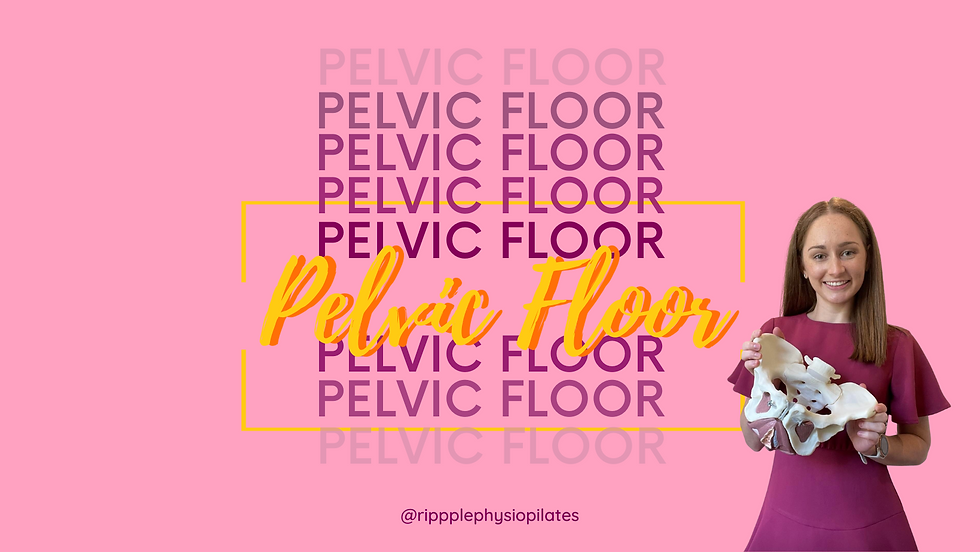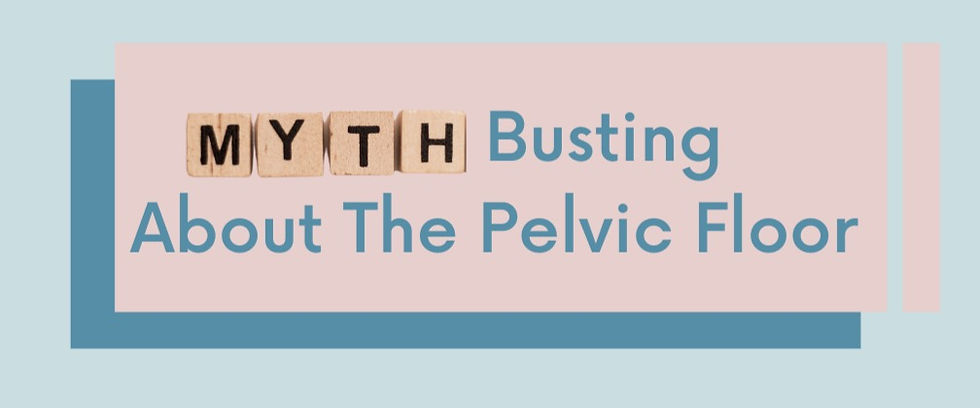WHAT IS YOUR PELVIC FLOOR?
- ripplepp
- Jan 5, 2023
- 5 min read
Updated: Jan 10, 2023
Written by Doctor Catherine McKelvey of Physiotherapy - Women's Health Physio

What is your Pelvic Floor?
My pelvic what?
The pelvic floor is a term we commonly use within the clinic. You may have heard a friend mention it before or maybe from your local GP. The term pelvic floor is slowly becoming a common topic of conversation within our daily lives. But, for those who are unfamiliar with the term it may be an illusive mystery that has you wondering what it is all about.
This blog is designed to answer all your questions, what it is, its role within our body, how it integrates into our anatomy and why it is important.
While the pelvic floor sounds simple, it is a complex structure, and the following information is designed to help break down the medical jargon into terminology you can digest and understand.
Lastly, we bust some common myths.
Myth 1: Only Females have a pelvic floor
Myth 2: Opting for a caesarean section to prevent dysfunction of the pelvic floor post-partum.
Myth 3: All pelvic floor dysfunctions are a result of pelvic floor muscle weakness.
What is the pelvic floor?
The pelvic floor is a complex web of muscles, ligaments and fascia that interconnect and attach to the bottom of the pelvic bones creating a ‘floor’ like structure as the name suggests. This supports the organs as well as aiding in bladder, bowel, and sexual function.
What is the function of the pelvic floor?
1. Support the pelvic organs
2. Maintain and control urinary and faecal continence
3. Allow sexual function and satisfaction
4. Provide stability to the spine and pelvic region
How do I know that I have Pelvic Floor Dysfunction?
You may experience signs and symptoms, including:

If these have resonated with you, know that you are not alone. An estimated 37% of Australian women live with urinary incontinence, 13% with faecal incontinence and 50% of women who have given birth will experience pelvic organ prolapse. This information will give you more insight into what is happening in your body, why it may be occurring and guide you towards the appropriate care.
Let’s understand our female anatomy...
What is the Pelvis?
The pelvis consists of 3 bones that form a ring, creating a pelvic cavity to support our 3 major organs. The pelvic floor connects these bones together to create the floor of the pelvis. The main landmarks of the pelvis include:
Ilium, the largest pelvic bone. If you place your hands on your hips you are sitting on your ilium
Ischial Tuberosity - these are also known as your sit bones
Pubic Symphysis- the bony like section at the front of your pelvis where both sides of your pelvic come together
Sacrum - the lowest part of the spine.
Sacroiliac Joint (SIJ): Where the Ilium's and Sacrum come together
Coccyx - known as your tailbone which attaches to the lowest part of the sacrum.

What are the Pelvic Organs?
The pelvic organs are housed within the pelvis being protected by the pelvic bones. Every organ has a storage part and a release part. The Anterior organ has the bladder which stores urine and the urethra which allows urine to exit the body, The middle organ is the uterus which houses baby during pregnancy and the vagina which is babies exit, lastly the posterior organ is the rectum to store faecal matter and anus to allow us to pass our bowels.

What are Pelvic Floor Muscles?
The pelvic floor muscles are a group of muscles that attach to your pelvis like a hammock and can contract and relax. Like we mentioned before these create the floor of the pelvis. There are different layers to the pelvic floor, superficial and deep.
The superficial layer made up of Bulbocavernosus, Ischiocavernosus and Transverse Perinei. They aid with continence and sexual arousal. This is often felt as a squeezing/closing sensation at the entrance to the vagina and rectum – Think that you are holding in a fart sensation or stopping the flow of urine on the toilet.
The deep pelvic floor muscles are known as the levator ani made up of Pubococcygeus, Iliococcygeus, Coccygeus and Puborectalis. These muscles support your pelvic organs (Bladder, uterus & bowel). This is often felt as a lift sensation inside, like your vagina is being drawn up.

If you are visual like me, check out this video from Continence Foundation Australia - https://www.continence.org.au/news/invisible-pelvic-floor-now-3d. Please note, while it suggests that everyone should do pelvic floor muscle contraction the way and type vary based on your body. Some may need to focus on relaxation (Example, pain with tampon insertion) while others may need to focus on strength (Example, leaking while running).
The Pelvic Fascia and Ligaments
There are 4 major fascia components, the function is to connect pelvic organs to pelvic side walls and suspend the organs. The stretching/tearing of the fascia can lead to prolapse of the organs. Think of fascia like puppet strings that suspend the organs (puppet) from above, while the pelvic floor supports from underneath.
There are three main principle ligaments including sacrotuberous, sacrospinous, and iliolumbar. The main role is to stabilise and strengthen the pelvis while assisting in transferring load.

Myth 1: Only Females have a pelvic floor
Nope, Both males and females too. While the external muscles are different, all the internal muscles are the same. One key difference is that women have a uterus and vagina. The uterus and the vagina are also why women experience more complications with their pelvic floor due to the stress on the muscles and organs during pregnancy and childbirth.
Myth 2: Opting for a caesarean section to prevent dysfunction of the pelvic floor post-partum.
Unfortunately, No. I hear this all too often when I ask if a client would like an internal examination post vaginal delivery. Despite not giving birth vaginally your pelvic floor muscles have been stretched and strained over 9months of carrying and supporting babies weight. It is recommended you complete post-partum pelvic floor exercises despite mode of delivery.
Myth 3: All pelvic floor dysfunctions are a result of pelvic floor muscle weakness.
I hope by now you can answer this one on your own, nope!
This could be a range of factors. Remember your pelvic floor is complex, dysfunctions may be related to hypertonic (low tone) or hypertonic (high tone) pelvic floor muscles, stretched fascia and ligaments or a combination.
By now you should understand what the pelvic floor is, why it is important and that it is a complex structure involving multiple structures that work in unison to maintain healthy sexual and bodily functions. In an ideal world everyone would have a healthy pelvic floor, unfortunately as we saw before tha is not always the case. This is where my role as a Women’s Health Physio comes in. We are specifically trained to treat bladder, bowel and sexual dysfunctions and can assist you in achieving a healthier pelvic floor. Whether you wish to experience pain free sex, continence with exercise or ability to hold in your wind.

If any of these has resonated with you, I urge to you to reach out via comments, emails or book a consultation to receive personalised assistance. If you liked this blog, leave us a like or comment and make sure to follow us for everything women’s health physio related.
Email: admin@ripplepp.com.au
Bookings: www.ripplepp.com.au
Questions: Comments below
Written by,

This information is an educational tool and is not intended for diagnosis or treatment of the pelvic floor.



Comments